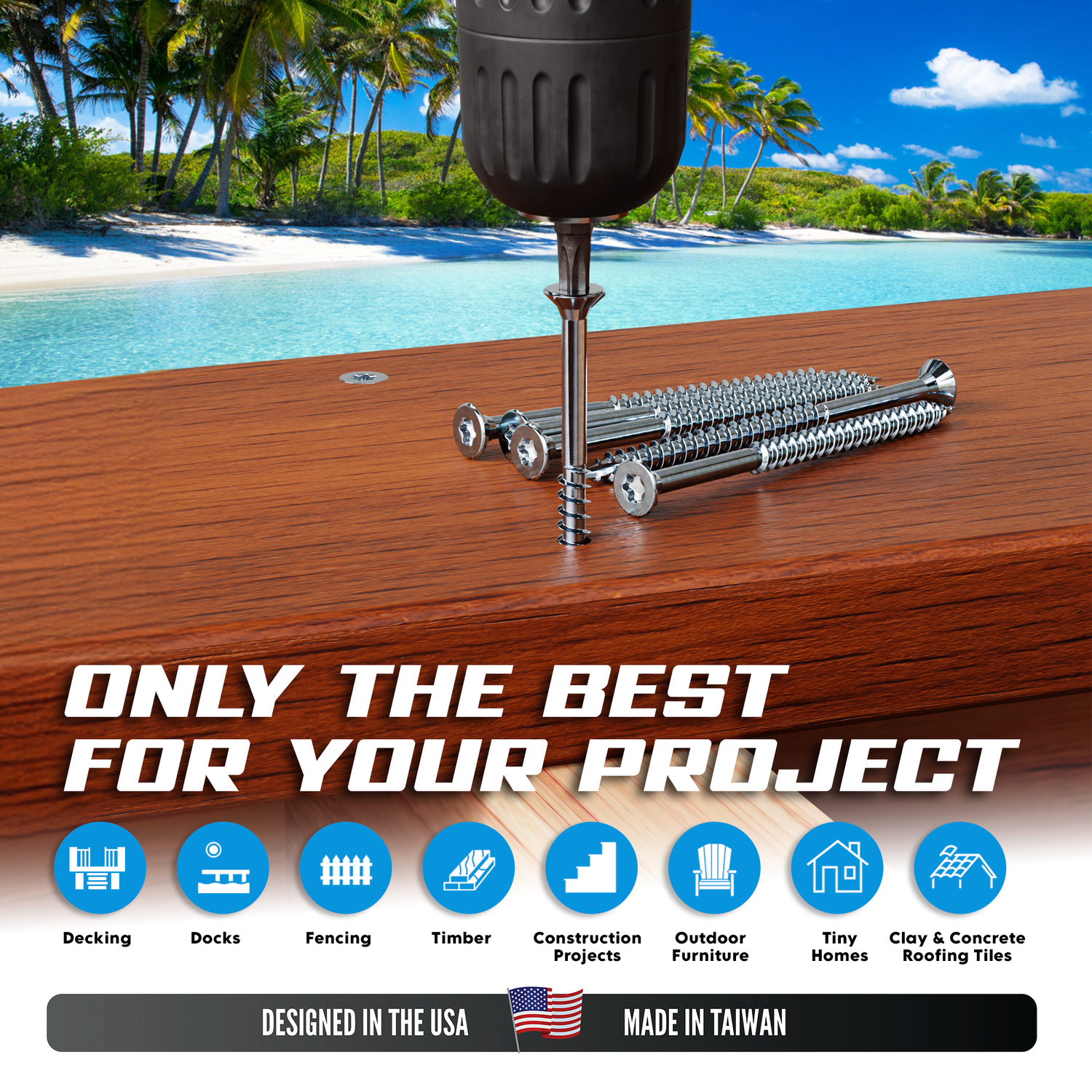
The Right Wood Screw Fixings for Durable Timber Structures
Share
Whether you’re building a deck, dock, roofing, saunas, or any timber construction project you’re tackling, you need to use the right wood screw fixings to make sure they are safe for your family and friends to use. There are qualities that you need to look for when choosing wood screws when building a timber structure.
The 8 Qualities of a Satisfactory Fastener for Timber Construction
1. Corrosion Resistance
Rusted screws can make the fasteners weaker. Corrosion can eventually compromise the durability and safety of your timber structures.
What to Look For: When selecting wood screws, always choose wood screw fixings that are made to resist corrosion effectively. If you're building your structure in wet environments, stainless steel screws are your best option.

316 stainless steel wood screws are designed to withstand the harshest conditions. With these screws, rain, humidity, and even saltwater, won't damage your fasteners for years. If your timber structure is 3 miles (or 5 kilometers) close to saltwater, still use 316 stainless steel wood screw fixings.
You can also use 304 stainless steel screws if you’re living in moist environments, they’re also cheaper than 316 stainless steel screws.
While you can use screws with a coated finish like zinc-coated screws, the coatings can degrade over time. This leaves stainless steel the more durable and long-lasting option.
2. Thread Design
If the thread design isn't designed for timber construction, it can cause loose connections. Loose connections affect the strength and stability of the whole structure.
What to Look For: Select screws with deep threads that can bite into the timber. For decking, dock framing, and sauna wall framing, this ensures a secure, long-lasting hold that can handle constant movement and shifting.
A deep thread design will hold the components tightly, preventing loosening or weakening over time, even when exposed to heavy loads or environmental changes. For example, screws with a deep, coarse thread are perfect for hardwood or pressure-treated lumber in decking or docks where strength and durability are essential.
3. Screw Length and Size
If screws are too long, they can go too deep and go through the material. If screws are too short, they might not grip the timber well, which can make the structure wobbly.

What to Look For: The length of the screw needs to match the thickness of the wood and the kind of connection being used.
When it comes to decking boards, choose wood screws that are either #8 or #10 in diameter. Also, choose fasteners that are long enough to penetrate at least 1-1/4 inches into the framing underneath.
When it comes to roofing, a common guideline is to choose screws that are about 1 to 1.5 inches longer than the thickness of the material you are securing. So, if you're working with 1-inch thick roofing shingles or plywood, use a screw that's 2.5 to 3 inches long. This size will make sure the screw stays tight, even when it's really windy and raining a lot.
4. Screw Head Type
A slipping screw or one that strips during installation can weaken the connections, risking the stability of a structure like docks, roofs, or saunas, where strength is critical.
What to Look For: A Torx head screw is ideal for these projects because the star drive provides superior torque, making it easier to drive the screw without slipping or stripping.
It's crucial for structures that face tough weather, like decks or docks, to have fasteners that stay secure, no matter the stress or the temperature changes (from freezing cold in winter to the intense heat of summer).
Using Torx head screws can help prevent damage to both the screw and the wood. This is especially true when you're dealing with high-tensile materials like those used in sauna walls or roofing.
5. Screw Tip
If a tip is poorly designed, it can make the installation challenging. You might end up with splintering, cracking, or having to use way too much force to get that screw in.
What to Look for: The Type 17 point is a great option for wood screws. It helps with easy penetration into wood, particularly when you're working with hardwoods or pressure-treated lumber.
The Type 17 point makes your timber construction less frustrating, helping to avoid any splitting or cracking of the wood and ensuring a smooth driving experience.
6. Durability Under Stress and Load
The screws need to be sturdy enough to deal with these stresses and keep everything in place, avoiding any shifting, wobbling, or failures that might put safety at risk.

So, when you're putting together decks, you’ve got people walking, sitting, or standing around, creating some foot traffic. Plus, the weight of your outdoor furniture, BBQ grills, hot tubs, and storage on your decks or docks puts pressure on the screws that are keeping the deck boards and joists attached to the framing.
What to Look For: Choose stainless steel screws. These wood screw fixings help keep the structure safe and sound, even when you place heavy furniture on your deck or have a lot of foot traffic.
7. Impact Resistance
Timber structures can face impact damage from a variety of sources. At the docks, boats constantly dock and undock, and you’ve got waves and floating debris hitting the structure, which puts extra pressure on the wood screw fixings.
Accidental strikes, such as someone dropping a heavy item, or maintenance tools being dropped onto the dock, can cause screws to bend or loosen if they're not built to withstand impacts.
What to Look For: Select screws that are hardened or made with premium steel alloys that provide resistance to impact. This is particularly important for outdoor structures like decks or other heavy-duty applications where impacts might occur, ensuring that the fasteners stay intact over time.
8. Wood Compatibility
Different kinds of wood come with their own unique densities, moisture levels, and hardness. If you use the wrong screw for a certain type of wood, you might end up with cracking, splitting, or it just not fastening properly. Choosing the wood screw fixings that match the wood you're working with helps make sure those connections are strong and last a long time.

What to Look For: If you're working with pressure-treated timber, 316 stainless steel screws are a great choice. And for hardwoods, you’ll want to go with Type 17 point screws to help minimize the chance of splitting. Stainless steel screws can be safely used in all hardwoods and softwoods, including redwood, and cedar.
FAQs
What are the best screws for fastening wood?
The best screws for fastening wood are the wood screws from Eagle Claw Fasteners and Simpson Strong-Tie. Eagle Claw stainless steel screws are rust-proof, with torx heads, and with a sharp Type 17 point. Simpson Strong-Tie has structural screws that can be used in ledger attachments and other structural components of your timber structures.
Do I need to pre-drill for wood screws?
Yes, we recommend pre-drilling, especially in hardwoods, to prevent splitting. The Starborn countersinking bit is a highly rated tool that we can recommend for drilling the pilot holes.
Is there a wood filler that will hold a screw?
Yes, epoxy wood filler is the best choice for keeping screws secure when fixing wood that has large holes or damage. For lighter tasks that don't need a lot of strength like furniture making or decorative woodwork, wood putty or polyurethane wood fillers can be a great choice.
Make sure to check the filled area before trusting it for strength, and think about the kind of wood and how you'll use it in your project before picking the filler.
For high-stress timber structures, like decking or roof framing, the smarter choice is to replace damaged wood or add extra hardware instead of just using filler.
How to secure screws in wood?
To start, make sure to pre-drill a clearance hole in the part you’re fastening and a pilot hole in the frame or substructure. Next, choose wood screws that are less likely to cam-out (strip the head), such as Torx screws. Next, position your arm and shoulder above the screw, and push down using a combination of your body weight and the strength from your shoulder and elbow.


